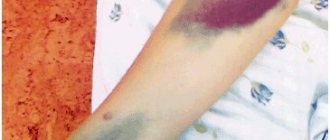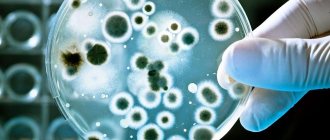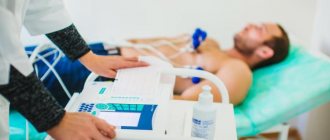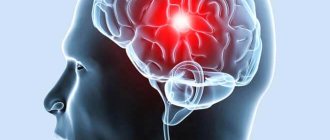Patau syndrome in children: karyotype, symptoms, signs
Patau syndrome is detected by DNA testing. In this case, there is an additional thirteenth chromosome. Patau syndrome is characterized by a combination of disorders in the functioning of the nervous system and internal organs.
Symptoms and signs of Patau syndrome:
- Low weight of the newborn. Usually the baby's weight is no more than 2 kg.
- Small head. There are anomalies in the structure and size of the skull. The head is very small.
- Clefts on the lips and palate. This defect is visible to the naked eye.
- Incorrect foot structure. The child's legs may be twisted, and club feet are often observed. Additional fingers are often present.
- Narrow eyes. The palpebral fissures are very small, which affects the child’s vision.
- Mental retardation. This is due to underdevelopment or absence of certain parts of the brain.
- Underdevelopment of the heart. These children are often diagnosed with heart defects.
- Anomalies in the structure of the ureters. Most often, the ureters are bifurcated.
- Abnormalities of the genital organs. In girls, bifurcation of the uterus and vagina is often observed.
Patau syndrome in children: karyotype, symptoms, signs
Patau syndrome in children: photos of newborns
Such children are very different in appearance from normal ones. The clefts and the strange size and structure of the skull are visible to the naked eye. The ears are located very low.
Patau syndrome in children: photos of newborns Patau syndrome in children: photos of newborns Patau syndrome in children: photos of newborns
Patau syndrome in children: causes of the disease
The causes of Patau syndrome are not fully known. But there is a category of parents whose risk of having sick children is higher.
Causes of Patau syndrome:
- Parents' age after 40 years. Mature parents are more likely to have children with genetic disorders.
- Connections between relatives. Often cousins have sick children.
- Ecology and life in a polluted environment.
- Genetic predisposition. Parents with Robertson syndrome often have sick children. At the same time, outwardly the parents are quite normal. The anomaly can only be detected after DNA analysis.
Patau syndrome in children: causes of the disease
Forecast
Trisomy 13 includes multiple abnormalities, many of which are life-threatening. More than 80% of children with Patau syndrome do not survive the first month of life.
For those who survive, complications are common and may include:
- Difficulty or lack of breathing (apnea);
- Deafness;
- Eating problems;
- Heart failure;
- Convulsions;
- Vision problems.
People who survive infancy have severe intellectual disability, developmental delays, and are at increased risk for cancer.
Living with a genetic or rare disease can affect the daily lives of patients and their families.
| Patau syndrome | |
| ICD-10 | Q 91.4 91.4 -Q 91.7 91.7 |
| ICD-10-CM | Q91.7 |
| ICD-9 | 758.1 758.1 |
| ICD-9-CM | 758.1 [1] |
| DiseasesDB | 13373 |
| MedlinePlus | 001660 |
| eMedicine | article/947706 |
| MeSH | D000073839 |
Patau syndrome
(
trisomy 13
) is a human chromosomal disorder characterized by the presence of an extra chromosome 13 in cells.
Patau syndrome - trisomy 13: type of inheritance
The most interesting thing is that this disease is called trisomy, which occurs on chromosome 13. It is not fully understood why an additional 13th chromosome appears. In this case, the additional chromosome can be transmitted from both the father and the mother.
Initially, disturbances may be in the sperm or in the egg. But most often the anomaly occurs after the formation of the zygote. This cell divides incorrectly and at a certain stage an additional chromosome appears.
Patau syndrome - trisomy 13: type of inheritance
Invasive methods
Using this method, developmental pathologies can be determined from the 8th week of pregnancy to the 12th week. The method is called chorionic villus biopsy. This procedure involves taking one of the layers of the fetal membrane for analysis. This is a relatively small amount of material for research, so chorionic villus biopsy does not negatively affect the further development of the fetus. The genetic material is taken by the doctor using a needle that penetrates the fetal membrane.
Amniocentesis
Diagnosis by this method is possible from 14 to 18 weeks of pregnancy. Unlike the first method, not the tissue material is taken, but a liquid sample. A special needle is inserted into the peritoneum and amniotic fluid is taken through it for analysis. It is important to maintain accuracy during amniocentesis, so the entire procedure is performed under ultrasound guidance.
Cordocentesis
Blood is taken from the umbilical cord for analysis. Perhaps this is the most difficult invasive method, because one wrong move by the doctor can end in disaster for the mother and child.
We recommend reading: Coconut oil, reviews and applications
Patau syndrome in children: incidence
Patau syndrome occurs quite often and is second in frequency only to Down syndrome. Approximately one child in 5-7 thousand is born with this diagnosis. Moreover, both boys and girls are equally susceptible to chromosomal disorders.
Patau syndrome in children: incidence
Patau syndrome diagnosis: biochemical screening
Throughout pregnancy, a woman undergoes three screenings. This is the donation of venous blood for the purpose of biochemical analysis. The first screening is carried out at 11-14 weeks, then at 16-18, and the last at 32-34 weeks.
Screening indicators:
- Initially, the concentration of certain hormones in the blood is determined. These are AFP and hCG and free estriol.
- The indicators can be used to determine Patau, Down or Edwards syndrome.
- The most interesting thing is that screening alone does not provide a 100% guarantee of the presence of syndromes. Additionally, an ultrasound is performed.
- In late pregnancy, amniotic fluid is collected.
- If the fears are confirmed, the pregnant woman is recommended to have an abortion.
Patau syndrome diagnosis: biochemical screening
Diagnostics
The diagnosis of Patau syndrome plays an important role, since it allows one to distinguish the disease from similar gene mutations (Meckel and Mohr syndrome, Opitz trigonocephaly), which in some ways coincide with trisomy 13. The decisive factor is the cytogenetic study of chromosomes (about the diagnosis of chromosomal pathologies of the fetus, you can read here). It is necessary for the prognosis of the life and health of children, and allows for timely termination of pregnancy when the diagnosis is confirmed.
Stage I
- Ultrasound examination.
- Determination of biochemical and physical markers of beta-hCG (chorionic hormone), PAPP-A (placental protein), etc.
- Calculation of the chances of having a baby with Patau syndrome.
Stage II
At this stage, diagnostics are carried out for those pregnant women who are at risk based on the results of stage I studies.
- 8-12 weeks: chorionic villus biopsy is taken;
- 14-18 weeks: amniocentesis is performed - a puncture of the amniotic membrane to examine the amniotic fluid;
- 20 weeks: cordocentesis - examination of umbilical cord blood.
In the materials obtained during these activities, geneticists look for pathology using the QF-PCR method or through karyotyping, differentially staining chromosomes. If no diagnosis was made during pregnancy, a chromosomal abnormality is identified based on the clinical picture. For an accurate diagnosis, genetic analysis is required to determine the karyotype of the newborn.
Educational program for parents. The most accurate method for diagnosing Patau syndrome is qf-PCR, which stands for quantitative fluorescent polymerase chain reaction.
Is it possible to see Patau syndrome on an ultrasound at 12 weeks?
An ultrasound scan may suggest Patau syndrome. Even though the child is still very small, the doctor may see some abnormalities.
What is determined by ultrasound at 12 weeks:
- Collar space
- Head size
- Bone length
- Abdominal circumference
- Symmetry of the brain hemispheres
- Presence of major organs
If a child has chromosomal abnormalities, this can be seen even at 12 weeks. The head in Patau syndrome is small, the cerebral hemispheres are asymmetrical. In addition, the size of the nasal bone may change. Extra fingers are often found.
If the doctor sees something strange on the ultrasound, the pregnant woman is prescribed additional tests. Genetic consultation is recommended.
Is it possible to see Patau syndrome on an ultrasound at 12 weeks?
Prevention
Patau syndrome is a disease that occurs unpredictably. At this point in time, doctors have not developed specific recommendations that, if followed, could prevent this disease in newborns.
All that can be said for certain is that in case of hereditary or genetic diseases in the family, as well as the mature age of the parents, one should consult with a specialist, undergo all the necessary examinations and be tested for laboratory genetic studies.
Patau syndrome in children: treatment
Patau syndrome cannot be cured. The disease is incurable, as there are disturbances in the development and structure of internal organs.
Common surgeries for Patau syndrome:
- Facial plastic surgery. Since with this disease there are often clefts on the lips, their plastic surgery is performed.
- Operations on internal organs. Usually the kidneys, ureters and heart are operated on. Doctors are trying to make caring for the child easier.
- In girls, the extra uterus is removed. Cysts are also removed.
- In general, all treatment is aimed at eliminating the symptoms of the disease and strengthening the immune system. It is necessary to alleviate the child’s condition in order to avoid inflammation of already unhealthy organs. Regarding mental development, such children are underdeveloped and will not be able to live a full life.
Patau syndrome is a serious genetic disorder that makes a child not independent. This is why doctors recommend termination of pregnancy before 22 weeks.
Birthday
Marina with her mother, grandmother and brothers
During her pregnancy, Alana learned that the child would have a cleft on her face. Much has been written about this feature. It is clear that the main thing in such cases is to restore the face, otherwise the child, for example, will find it difficult to eat, and this will lead to digestive problems. But, in general, you can live with this. The parents decided they could handle it.
During an examination before birth, the doctor noticed that there was something wrong with the fetus’s vision. The eyeballs were two times behind the norm in terms of indicators. It was difficult to see a specific problem back then. This was the second blow for Alana, and it was harder to overcome. My husband supported me: in the end, he said, you can have an operation, it won’t help - nothing, even completely blind people can study and work. Everything will be fine.
When her daughter was born, the doctors asked her mother if she really wanted to see her. Alana was ready for anything. They quickly showed her the child and took him to intensive care.
Alana – about the first months of Marina’s life: “It seems like so much time passes before she starts breathing again.”
Marina lay in intensive care for twelve hours. Then, when she began to breathe steadily, she was transferred to the postpartum ward. I don’t even remember what happened and what didn’t happen - she was given a lot of medications, she was on IVs all the time, her platelets dropped significantly.
She had such severe swelling that hemorrhage could happen at any minute. And with all this, it was necessary to move on to the next stage - the maternity hospital cannot keep us all the time. But no one wanted to take us - no one at all. All hospitals simply refused.
It only worked with the Center for Family Planning and Reproduction on Sevastopolsky Avenue. I accidentally heard a pediatrician talking about our case on the phone with someone from the administration, or rather, shouting: “I can’t throw them out into the street.” After that they took us.
I asked permission to always be with my daughter because I didn’t know how much time we had. I was allowed to do absolutely everything with her. Marina was then fed through a tube, and I suggested removing it and feeding it by hand - we had special spoons for children with facial clefts. The doctors looked at me as if I was crazy. But there was one nurse, also one of the adventurers, and she and I decided to try.
I will always remember these numbers: Marina took 18 milliliters of milk for an hour and a half, she had to be fed every two hours - that is, an hour and a half to eat, half an hour to sleep - and again, and so on around the clock. But she ate, and that was the most important thing. We didn't think that she would ever get off the probe. Marina seemed to give us a sign: just give me the opportunity, and I will do everything.
From the Center on Sevastopolsky we were transferred to Solntsevo (Scientific and Practical Center for Specialized Medical Care for Children named after Voino-Yasenetsky). There Marina continued to receive IV drips. When the course ended, we were discharged with parting words to live until six months - after which we can have surgery.
We were driving home from the hospital by taxi, Marina was lying in my arms - tiny and good, like candy, and then I looked down and saw that she was gray. She experienced respiratory arrest for the first time. We had an Ambu pillow with us (an Ambu bag is a manual device for artificial ventilation of the lungs), we took it out and began to do everything to get Marina started. Started up. Let's move on.
The cessation of breathing then often repeated. And you can even get used to this. We pumped her out with great difficulty several times. It seems like everything was done according to the instructions, they performed cardiac massage and artificial respiration, but she still hangs in her arms without breathing, and you can’t do anything. You feel your own powerlessness: the child does not respond, does not return.











